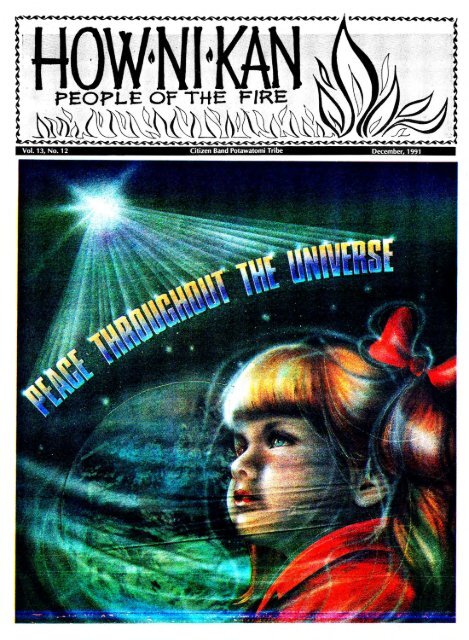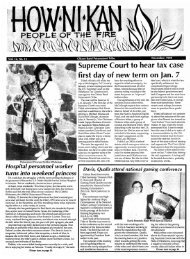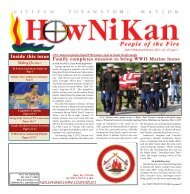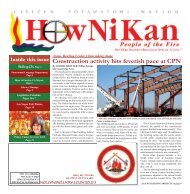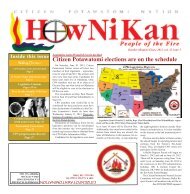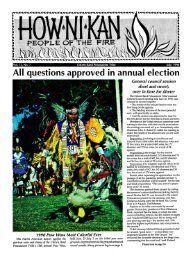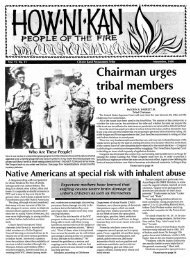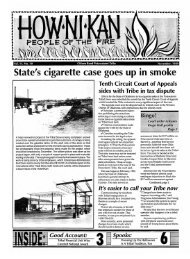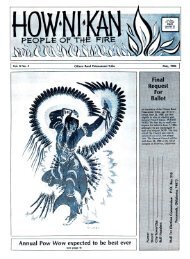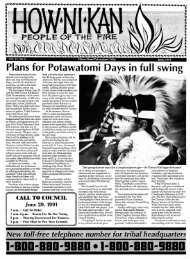Vol. 13, No. 12 Citizen Band Potawatomi Tribe December, 1991
Vol. 13, No. 12 Citizen Band Potawatomi Tribe December, 1991
Vol. 13, No. 12 Citizen Band Potawatomi Tribe December, 1991
Create successful ePaper yourself
Turn your PDF publications into a flip-book with our unique Google optimized e-Paper software.
<strong>Vol</strong>. <strong>13</strong>, <strong>No</strong>. <strong>12</strong> <strong>Citizen</strong> <strong>Band</strong> <strong>Potawatomi</strong> <strong>Tribe</strong> <strong>December</strong>, <strong>1991</strong>
Page 2 • HowNiKan • <strong>December</strong>, <strong>1991</strong> • <strong>Vol</strong>. <strong>13</strong>, <strong>No</strong>. <strong>12</strong><br />
Dallas regional office 'fire' burning brightly<br />
The Dallas Regional "Fire" has<br />
been burning bright with excitement<br />
the past two months for<br />
projects currently underway and<br />
plans iOT the future within the<br />
tribe. We have been contacting<br />
area tribal members by telephone,<br />
direct mailings (thank<br />
yaul volunteers!), press releases<br />
and radio announcements on the<br />
KNON-FM 89.3 "Beyond Bows<br />
and Arrows: show. The response<br />
has lx.-en very positive.<br />
Contact has also been made<br />
with several mctroplex American<br />
Indian Organizations including<br />
The American Indian Center,<br />
Dallas Inter-Tribal Center and the<br />
American Indian Heritage Center<br />
of Texas. We were well represented<br />
at the <strong>No</strong>vember meeting<br />
of the American Indian Chamber<br />
of Commerce for those inl('Tf'stf'd<br />
in business networking. All of<br />
these organizations have been<br />
extremely receptive to Ollr<br />
opening and eager to lend a<br />
helping hand in learning more<br />
about the "Native American<br />
Society."<br />
We ha ve recei ved a good<br />
initial response In our recent<br />
questionnaire. For those of you<br />
unaware, our members have<br />
requested information on such<br />
topics as available benefits,<br />
New Employee<br />
Teresa Lauderdale, pictured above, is a new tribal employee<br />
working in the <strong>Potawatomi</strong> Museum and Gift Shop<br />
under the On The Job Training Act. Teresa is a clerk in the<br />
gift shop and also does a little beadwork when things are<br />
quiet.<br />
possible business networking,<br />
cultural/historical information<br />
and genealogical help. We are<br />
gathering material in response to<br />
these needs and ask that you<br />
watch for some of the answers in<br />
your HowNiKan. 'A'e look<br />
forward to hearing from each and<br />
every one of yOll with questions,<br />
needs, ideas, or holiday cheer!<br />
Happy Holidays!<br />
Kim Anderso", <strong>12</strong>14J399-<strong>13</strong>45<br />
Help needed<br />
to organize<br />
newpowwOW<br />
Drums, singers and participants<br />
are being sought for a new<br />
"Potawalorni Days Powwow"to<br />
be held in late summer in St.<br />
Charles, Illinois.<br />
Jim Dowd of SI. Charles, who<br />
has worked with the Forest<br />
Community, Pokagon <strong>Band</strong>,<br />
Prnirie <strong>Band</strong> Jnd some IlIionois<br />
members of the <strong>Citizen</strong> <strong>Band</strong>, is<br />
coordinating the POWWO\V for the<br />
Sl..CharIL"'S Historical Society.<br />
Dowd said in a letter to Tribal<br />
Chainnan John A. Barret that he<br />
plans a traditional pow wm.\'<br />
with 6-10 drums, but other<br />
details are yet to be worked out.<br />
"jf you and others of the<br />
<strong>Citizen</strong> <strong>Band</strong> can help, we will all<br />
be grateful," Dowd s..--.id in his<br />
leiter. As plans unfurl, it would<br />
be grand if the HowNiKan could<br />
carry information to the many<br />
<strong>Potawatomi</strong> people across this<br />
land who might be intersted in<br />
meeting their brothers and sisters<br />
from across this CQuntrv and<br />
Canada." He said they ~"ill need<br />
drums dnd singers, dancers,<br />
traders and crafts people, and<br />
will need commitments from<br />
thelll soon.<br />
Contact Dowd at 38W281<br />
Toms Trail Dr., SI. Charles, IL<br />
60175 «(708)584-1930 if in tL'rested.<br />
HowNiKan<br />
donations listed<br />
William E. & Rae Marie Anderson,<br />
WA, $50<br />
Bernice G. Ricioppi, CA, $10<br />
Vernon Motiey, OK, $20<br />
Vina Pruett, MO, $4<br />
Evelyn Clevenger, CA, $10<br />
Gladys Moeller, KS, $25<br />
Pauline Shearer, TX, $20<br />
Cheryl M. Smith, TX - $50<br />
Grace E. Stockton, CA - $30<br />
Cherie L. Fabion, OH - $100<br />
Cindy L. Michalski, IL - $5<br />
<strong>No</strong>rma J. Meece, NC - $10<br />
Remainder of<br />
regional council<br />
schedule listed<br />
Jan_ 11- I'hoenix, Ariz.<br />
Feb. 8 - Long Beach, Calif_<br />
Feb_ 22 - Portland, Ore.<br />
March 14 - Kansas City, Mo.<br />
April 5 - Tulsa, Okla.<br />
April 18 - Sealtle, Wash.<br />
May 2 - Houston, Tex.<br />
Don't forget to RSVP!<br />
Show<br />
Your<br />
Pride<br />
Project Safe Executive Director Jennifer Freed, Tribal Health Services Director Joyce Abel,<br />
Indian Child Welfare Worker Rick Short<br />
<strong>Tribe</strong> awarded funds for domestic violence work<br />
The <strong>Citizen</strong> <strong>Band</strong> <strong>Potawatomi</strong><br />
<strong>Tribe</strong> was recently awarded<br />
funding from the Administration<br />
of Children and Youth for the<br />
Family Violence Prevention and<br />
Service Program which they used<br />
to support Project Safe, services<br />
for victims of domestic abuse_<br />
The tribe and Project Safe have<br />
entered into an agreement in<br />
which Project Safe will accept<br />
referrals for shelter needs_<br />
Project Safe, which offers<br />
shelter, food, transportation and<br />
crisis counseling for battered<br />
women and men, will use the<br />
$5,000 given to them by the tribe<br />
for the immediate shelter of<br />
Indian victims of family violence<br />
and their dependents.<br />
In addition, Project Safe will<br />
provide community prevention<br />
workshops for at risk families<br />
and the professional staff of other<br />
agencies working with victims of<br />
family violence_<br />
Referrals can be made-to<br />
Project Safe when any of the<br />
Shawnee area tribes are notified.<br />
Other services such as supportive<br />
crisis counseling, drug abuse<br />
counseling or transportation to a<br />
relative's home are provided.<br />
The goal is to establish or<br />
expand projects to prevent<br />
violence in Native American<br />
families and provide shelter and<br />
help for Indian victims of family<br />
violence and their children.<br />
Introducing a credit card<br />
with a big difference· ..<br />
Support for the<br />
<strong>Citizen</strong> <strong>Band</strong> <strong>Potawatomi</strong> <strong>Tribe</strong>!!<br />
It's the credit card that your family and hiends bave been talking<br />
about! I The <strong>Citizen</strong> <strong>Band</strong> <strong>Potawatomi</strong> <strong>Tribe</strong> VISA Card_ The <strong>Citizen</strong><br />
<strong>Band</strong> <strong>Potawatomi</strong> <strong>Tribe</strong> VISA gives you the glUt cardholder benefits<br />
you expect from VISA while generating income for the <strong>Citizen</strong> <strong>Band</strong><br />
<strong>Potawatomi</strong> <strong>Tribe</strong> for education. bealth, and other tribal services.<br />
Bearing the tribal seal of the <strong>Citizen</strong> <strong>Band</strong> <strong>Potawatomi</strong> <strong>Tribe</strong>, the<br />
<strong>Citizen</strong> <strong>Band</strong> <strong>Potawatomi</strong> <strong>Tribe</strong> VISA tets you show pride in your<br />
heritage.<br />
Why walt any longer?<br />
CaD 1-800-456·2273 for an application today!!!
<strong>Vol</strong> <strong>13</strong>, <strong>No</strong>. <strong>12</strong> • <strong>December</strong>, <strong>1991</strong> • HowNiKan • Page 3<br />
learning A New Craft<br />
Tribal members and others participating in the elderly nutrition program also enjoy a variety of craft classes. One of the most recent involved learning<br />
how to make macrame seat covers for aluminum lawn chairs. In the photographs above, Ruby Harris, left, uses bright purple on her chair, while<br />
at right, Hazel Threlkeld works with a rusty brown color.<br />
Tribal member arranges donation<br />
of ambulance for lakota reservation<br />
(From The Mount Washin~t('" Star·<br />
Review, California) - Jason Bloomberg's<br />
quiet voi~e wd::; mure than loud enough<br />
Friday to inform a select gathering at the<br />
Southwest Museum of the medical flight<br />
faced by residents of the Oglala Lakota<br />
alion, by living on the Pi Ill' Ridge<br />
Reservation in South Dakota.<br />
Bloomberg, an emergency medical<br />
technician who is fire chief of the Oglala<br />
<strong>Vol</strong>unteer Fire and Ambulance Service,<br />
\·V3S in Los Angeles to accept the donatinn<br />
of an ambulance form Coodhcw Ambulance<br />
Service.<br />
Bloomberg said his service now has,<br />
with the (1rjdition, five ambulances to<br />
serve the 1600 square mile reservation.<br />
The true need, he said, would be in the<br />
neighborhood of 19 or 20.<br />
Blomberg said for years federal authorities<br />
denied the needs existed for Clnergency<br />
medical services. When the volunteer<br />
program was finally started, with<br />
another donated ambulance, the calls<br />
came in and they never stop.<br />
Bloomberg spoke of some injured and<br />
illtribesmembers brought (or treatment in<br />
open trucks, sometimes in weather \Nith 65<br />
below winG chill factor. Sometimes the<br />
trip can be 80 to 100 miles, he said.<br />
The donation of the ambulance was<br />
arrnnged through the efforts of
Page 4 • HowNiKan • <strong>December</strong>, <strong>1991</strong> • <strong>Vol</strong>. <strong>13</strong>, <strong>No</strong>. <strong>12</strong><br />
Ii<br />
I'<br />
.j<br />
II<br />
,I<br />
Ii<br />
Ii<br />
I<br />
CI'ainnan John A. Barrett Welcomes<br />
a Large Crowd And Wishes<br />
Them A Happy Holiday<br />
Tribal Members And Guests Fill Their Plates From A Wide Selection Of Salads, Vegetables And Desserts. In Addition<br />
To TIle Turkey, Dressing Alld Ham Provided By The Kitchen, Dillers Brought TIleir Favorite Holiday Dishes<br />
To Slwre. Witl, Their Friends.<br />
I<br />
, I<br />
Cood Felluwship Is Just As I"'portallt As Good Food At Holiday GI/therillgs. Special<br />
Lvellts Bring Guests As Well As Extra-Large Nu",l"rs OfT/lOse Who Regularly Take<br />
Advalltage OfTh" Llderly Nutritioll Progrlllli.<br />
<strong>No</strong>la Ln1VSOIl, Right, \'\1011 The Fruit Basket Ghlel/ A'ivny<br />
At TI,,' Di",,,,,. She Is Pictured With I.Yllda Poe, Title VI<br />
Co onl infl tor.<br />
\':--------_._-,--"--'<br />
. :.--"----------'=-"-::'- -::'::"=-:.::'========
.lijYijijtliill~iil<br />
Student thankful for articles<br />
Dear HowNiKan,<br />
Many thanks for the useful articles you continue to print. I love to<br />
read and learn mOTe about my heritage each month. I want to<br />
specifically thank you for your printing of Alexander B. Copley's<br />
"The Pottawattomies-Recollections From ;the 1800's'" This article hd,<br />
helped tremendously with two term papers so far.<br />
I am a rduming student back to school after thirtecn Yl'MS. Your<br />
articles have made the research of a paper less difficult.<br />
I have always thought of myself as Potaw~Homiilnd \v.15 able to<br />
become a memlx'T in the past few years. Being other nationalities as<br />
well, the fact that the tribal rolls 'oNere open has giVL'11 me a real scnsL'<br />
of belonging somcwh('Tc. ContinuC'd success to yOll tlnd the tribe.<br />
Cindy Michalski<br />
Glenwood,IL<br />
A tribute to a tribal member<br />
<strong>Vol</strong> <strong>13</strong>, <strong>No</strong>. <strong>12</strong> • <strong>December</strong>, <strong>1991</strong> • HowNiKan • Page 5<br />
Holiday Hours: Monday throught Friday 8 a.m. - 5 p.m. / saturday 9 a.m. - 5 p,m.<br />
Size Price Amount<br />
Dear Friends at HowNiKan:<br />
How-Ni-Kan Caps<br />
11.95<br />
Please help me to pay tribute to a very deserving young lildy!<br />
How-Ni-Kan Visors<br />
9.95<br />
Christina Kirby Baggarly, daughter of Karen Whillington and<br />
granddaughter of Bob Qualls and Billie LaClilire QUillls
Page 6 • HowNiKan • <strong>December</strong>, <strong>1991</strong> • <strong>Vol</strong>. <strong>13</strong>, <strong>No</strong>. <strong>12</strong><br />
.. .<br />
.' .<br />
........<br />
.... . ..<br />
.. ... .<br />
:-:.»>: :-:-:-:.: «cently torml'd a<br />
task fOTce to fOCllS on this issue. VVl' und
<strong>Vol</strong> <strong>13</strong>, <strong>No</strong>. <strong>12</strong> • <strong>December</strong>, <strong>1991</strong> • HowNiKan • Page 7<br />
Sac and Fox battle wage suit<br />
In March 1989. members of the Sac and<br />
Fox tribe proudly announced the signing<br />
of a $30 million government contract to<br />
manufacture 491,OCKJ chemical warfare<br />
outfits for the military.<br />
5o,e (md Fox InduslriL's hJd just landl'd<br />
the largest garment contract ever awarded<br />
by the Defense Department to an Indianowned<br />
business, company president<br />
James Branum told reporters at the time.<br />
But the four tribal company plants<br />
abruptly shut down almost a year ago.<br />
The government contract was canceled<br />
after delivery of only <strong>13</strong>,350 suits.<br />
Today, members of the Sac and Fox<br />
board of commissioners and Branum are<br />
defending them-selves in court ag
Page 8 • HowNiKan • <strong>December</strong>, <strong>1991</strong> • <strong>Vol</strong>. <strong>13</strong>, <strong>No</strong>. <strong>12</strong><br />
II NATIONAL NEWS ]<br />
Oklahoma man files complaint against KC Chiefs<br />
An Oklahoma man filed a complaint area, including Ihe Heart of American<br />
againstlhe Kansas City Chiefs on<br />
Indian Center.<br />
Wednesday, claiming his religion and ''In our opinion, Mr. Haney's opinion is<br />
identity as an Indian have been attacked. not shared 'with other American Indian<br />
Michael S. Haney, vice chairman of the groups," Moore said.<br />
Newcomer <strong>Band</strong> of the Seminole Nation Famous Marshall, il spokesman for the<br />
of OklClhoma, filed the complaint filed Seminole nation oi Oklahoma in \'\'cwoka,<br />
\vith the Missouri Commis~ionon Human Okla., said Haney has J1() "speaking voicc"<br />
Rights.<br />
for the Seminole Nation.<br />
In it, he says the Chiefs aided in the Haney, of McLoud, Okla., announced<br />
spread of racial and religious di~riminil- that he h
<strong>Vol</strong> <strong>13</strong>, <strong>No</strong>. <strong>12</strong> • <strong>December</strong>, <strong>1991</strong> • HowNiKan • Page 9<br />
Esther Lowden wears Native American clothing featured in the Tribal Gift Shop. Gift shop<br />
items are popular at the regional meetings.<br />
--<br />
Matt Veitenheimer holding his grandson Daniel. His daughter,<br />
Donna Devincenzi holds her other son, Justin.<br />
William Sweeney, left, and daughter Clare Sweeney, right, received a<br />
hat and earrings for traveling the longest distance.<br />
-.<br />
.-<br />
f,;.<br />
Clara Curtes, 88, received a white shawl for being the eldest member<br />
present. Clara is from Sacremento<br />
A near-youngest tribal member is Jacob Tyler Lewis. Jacob was<br />
born July 18, <strong>1991</strong>. He is pictured with his mother, Shirley<br />
Hackel!.<br />
Youngest member present was Alisa Melot, born July 27, <strong>1991</strong>. She is<br />
pictured \vith her mother Suzanne Melot of San Jose.
Page 10 • HowNiKan • <strong>December</strong>, <strong>1991</strong> • <strong>Vol</strong>. <strong>13</strong>, <strong>No</strong>. <strong>12</strong><br />
Anderson family story: fact and legend closely related<br />
Yesterday aflernoon while Ihe<br />
chimes ofa merry Christmas were<br />
still ringing in the ears of the<br />
children of this world another btoody<br />
crime was recorded on Oklahoma's<br />
sanguinary calendar. Another man<br />
was killed and today seven children<br />
in his home mourn for him and<br />
refuse to be comforted. The county<br />
jail contains another priS(lnCr and<br />
the lax payers of the cOllnty will be<br />
at the expense of his trial the rC5111t of<br />
which no living man can foretell.<br />
("Hot Winchesters" published ;11<br />
The Evening Gazette, Oklahoma<br />
City, Oklahoma, Saturday,<br />
<strong>December</strong> 27, 1890.)<br />
In 1871, Pete Anderson (age<br />
27) and his wife, Julia (age 16).<br />
came to the "Pott Country" with<br />
the first group of <strong>Citizen</strong> <strong>Band</strong><br />
<strong>Potawatomi</strong> families to relocate<br />
from Kansas. Pele was born in<br />
Illinois in about 1845 and \fo/
<strong>Vol</strong> <strong>13</strong>, <strong>No</strong>. <strong>12</strong> • <strong>December</strong>, <strong>1991</strong> • HowNiKan • Page 11<br />
New national museum, 'Fourth Museum' to preserve heritage<br />
By W. Richard West Jr., Director<br />
National Museum of the American Indi.lll<br />
Smithsonian Institution<br />
Washington,D.C.<br />
In the laic 191h century, Captain R.H. Prall. lhe first Supc'rintendenl of the Carlisle<br />
Indian BoardingSchool in Carlisle, Pa., made the following observations fl'g
Page <strong>12</strong> • HowNiKan • <strong>December</strong>, <strong>1991</strong>· <strong>Vol</strong>. <strong>13</strong>, <strong>No</strong>. <strong>12</strong><br />
--Native American Women's Clothing--<br />
(Reprinted "Indian Clothing of The Great<br />
Lakes: 1740-1840". Eagles View Publishing<br />
Co., Ogden, Utah. Auai/able at the Tribal<br />
Museum and Gift Shop $9.95,)<br />
Clothing styles were similar for lnost<br />
Great lakes Indian '<strong>No</strong>men. The real<br />
differences were in the treatment of the<br />
gannent with ornamentation which was<br />
based in part on the individual ability and<br />
resources for the materials necded. The<br />
chiefs and sachems were responsible for<br />
the distribution of annuity payments cllld<br />
were usually the first ones to meet with<br />
the traders who furnished the goods.<br />
Those \vho did not stand in good favor<br />
with a leader or who weTe not influential<br />
\vith the \vhite trader, did not always<br />
receive the choice merchandise. Often<br />
women and children weTe not included on<br />
payroll and payment lists, so they received<br />
what was left over (Blackburn 1942:<br />
pp.392-393).<br />
In giving presents during the 19th<br />
century, the donors adhered to the rule of<br />
precedence in rank. The common Indian's<br />
wife received only a piece of stroud to be<br />
used for a blanket and petticoat. The<br />
stroud, being a cheap cloth made of<br />
\voolen rags, was quite different from the<br />
fine material given to the chief's wife. The<br />
chief and sachems were frequently the<br />
beneficiaries of special goods such as<br />
clothing and jewelry for their families<br />
(New York Colonia/ Docllments, VIl: p. 186).<br />
In contrast, those Indian \-vomen who<br />
were involved in tribal politics and had a<br />
say in the activities of the warriors often<br />
made requests for specific items such as<br />
smaller size blankets, scarlet hose, lively<br />
colored calicoes, ribbons and gartering.<br />
Color listings for textiles and laces included<br />
such hues and shades as deep red,<br />
deep blue, green scarlet and yellow. Silk<br />
handkerchiefs, silver rings, ear bobs and<br />
barley corn beads also found their way<br />
into feminine hands. These items portrayed<br />
the brighter side of life for the'<br />
women (facobs 1967: pp. 46-47).<br />
A letter dated January 8, 1783 to<br />
Francios Bosscron at Vincennes form<br />
Pierre Latoure at Petit~Duabachc(trading<br />
post in central Indiana) included a c()m~<br />
plaint that the merchandise was too<br />
expensive. Even with enticement, the<br />
Indians refused to trade (Lassellc Papers,<br />
Charles B 1781-1785: p. 165). Knowledge<br />
of the suitability of trade items wa~<br />
considered to be essential to the success oi<br />
trade with Indians. From the time of the<br />
treaty of Lancaster in 1748, presents of<br />
textiles and hardware and munitions wC're<br />
to be used for securing warriors in prepara<br />
tion for the eventual conflict between<br />
the French and the British for control of<br />
the New World. This gave the Indians the<br />
opportunity to demand the best from both<br />
sides.<br />
WRAP-AROUND SKIRT AND BLAN<br />
KET<br />
Throughout the eastern United States,<br />
the basic gannent of native women was a<br />
wrap-around skirt. It was worn from<br />
Georgia north into Quebec and as far west<br />
as eastern Kansas and Minnesota. Prehistoric<br />
stone and ceramic sculptures form<br />
the east indicate that the wrap-around<br />
skirt may in fact have been one of the most<br />
long lasting and widely worn of all Native<br />
American clothing forms. Until the 18th<br />
century, these garments were made from<br />
native woven cloth or animal skins.<br />
Possibly a few women living adjacent to<br />
Europeans had skirts of trade cloth<br />
(Cumming 1972: pp: 272-273, 285).<br />
Records from the mid-18th century<br />
indicate the skirts worn by the Indian<br />
\-vomen were made fonn trade cloth. "..<br />
they have a short blue petticoat, which<br />
reaches to their knees and the brim of<br />
which is bordered with red or other<br />
ribbons ..." (Ka!l111772: p. 116). John<br />
Hecke\'velder, who traveled an'lOng the<br />
Ohio Country Delaware Jnd Mohicans,<br />
observed that the women, at the expensl'<br />
of their husbands or lovers, lined their<br />
petticoats with blue or scarlet cloth<br />
blankets or covering with choice ribands<br />
of various colors, or wi th gartering nn<br />
which they fixed c1 number of silver<br />
brooches, or small round buckles. They<br />
adonH:,d the leggings in much the same<br />
manner (Panl1Jlbecker 1986).<br />
Reverend David Zeisberger refers to the<br />
clothing of the Indian women as follows:<br />
"...the dress which particularly distinguishes<br />
the women is a petticoat or<br />
stroud; blue, red or black, made of a pieo.'<br />
of cloth about two yards long, adorned<br />
with red, blue or yellow bands laid double<br />
and bound about the body." In the same<br />
paragraph, Zeisberger refers to these<br />
bands as being of silk and also calls them<br />
ribbon. <strong>No</strong> design or technique is mentioned<br />
(Pannebecker 1986).<br />
Heckewelder adds that "the wealthy<br />
adorn themselves besides with ribands<br />
and gartering of various colors, beads and<br />
silver brooches. These ornaments arc<br />
arranged by the women, \'\'ho, as well as<br />
the men, know how to set themselves off<br />
in style.<br />
"Delaware men pay particular attention<br />
to the dress of their women, and on that<br />
account clothe themselves rather meanly.<br />
There are many who think it scandalous to<br />
appear better clothed than their wives,"<br />
John Heckewelder observed in 1762.<br />
Delaware men love to see their v·:ives well<br />
clothed, which is a prouf that they are<br />
fond of them, at least in Heckewclder's<br />
estimation (Wallace 1985: p. 56).<br />
In 1788, a painting by Thomas Davic~<br />
reveals that Huron won1L'n of Quebec<br />
wore brightly printed calico trade shirts<br />
over wrapped skirts. The skirts reveal<br />
ribbon edging and on some, alternate usc<br />
of colors (Schoo/cmft 1980: p. 145).<br />
"\Vomen wore petticoats, reaching<br />
below the knee. The iabric was stroud<br />
which was first washed giving the fabric a<br />
chance to shrink to produce a felt-like ieel<br />
and look. Some also wore garments of<br />
printed linen or cotton of various colors,<br />
decorated at the breast with a great<br />
number of silver buckles, which arc also<br />
worn by some as ornaments upon their<br />
petticoats ...They adorn their ears, necks<br />
and breasts with corals, small crosses,<br />
little round escutcheons, and crescenls,<br />
made either of silver or wampum"<br />
according to Losklel in 1794 (Loskiel, C.H.,<br />
HIstory of the Missions of Uniled Brethrw<br />
Among the Indians of N. AmeriCfl: by CI.<br />
LaTrobe).<br />
A vivid description of early clothing<br />
worn by a bride at Michilimackinac was<br />
praised by editor R. C. Thwaites as Mrs.<br />
Baird reminiscences about the wedding<br />
garment worn in 1819: "The skirt reached<br />
about half-way between the ankle and the<br />
knee, and was elaborately embroidered<br />
with ribbon and beads on both the lower<br />
and upper edges. Above this horizontal<br />
trimming were rows upon rows or ribbon,<br />
four or five inches wide, placed so near<br />
together that only a narrow strip of cloth<br />
showed like a narrow cord. Accompanying<br />
this was worn a pair of leggins made<br />
of broadcloth ... the embroidery about<br />
three inches form the side edge. Around<br />
the bottom the trimming is between four<br />
and five inches in width. The moccasins,<br />
also, were embroidered with ribbons and<br />
beads." Baird noted that similar ensembles<br />
were worn by the bride's Indian mother,<br />
and two women traders of French and<br />
QUa wa extraction.<br />
STRAP DRESS<br />
Frances Densmore obtained descriptions<br />
from Minnesota Chippewa Indians<br />
of women's clothing form the early fur<br />
trade period. "In early times the clothing<br />
of a \...../oman consisted of a binary garment<br />
made of two deerskins, one forming the<br />
front and the other forming the back of the<br />
dress, the two pats bieng fastened together<br />
at the shoulders and held in place by a<br />
belt" (Densmore 1979: p. 31).<br />
\'\1hat may have been the earliest form<br />
of a binary dress, the strap dress, once<br />
worn from <strong>No</strong>rtheast Canada and west to<br />
the foothills of the northern Rockies, was<br />
noted by Alexander Mackenzie as early as<br />
the 17905. Made from two large pieces of<br />
leather trimmed into rectangles, sewn<br />
together along the sides and supported by<br />
shoulder straps; this version of the binary<br />
dress covered the wearer from above the<br />
breast to midcalf (Conn 1974).<br />
Richard Conn of the Denver Art<br />
Museum made this comment about the<br />
extensive use of the strap dress throughout<br />
the northern Great Lakes and prairies:<br />
. the strap dress was often \vorn with<br />
separate leather sleeves. the use of these<br />
removable sleeves in a climate which<br />
would rarely require their removal is<br />
difficult to explain except in terms of the<br />
limited availability of hides ..." (Conn<br />
1974).<br />
When the traders brought broadcloth, a<br />
woman might have made a similar dress<br />
of cloth, but she always had a dress of<br />
hides for usc when she was a at work. To<br />
this were added moccasins, leggings Clnd a<br />
blanket. Four kinds of broadcloth wE're<br />
carried by thest' early traders and used ttl<br />
make the strap dresses and leggings. The<br />
cheapest quality was dark blue, coarse<br />
stroud cloth with a white border. Enough<br />
of this for a vvoman's dress cost the<br />
equivalent of five ($5.00) dollars ill furs.<br />
The three other kinds cost about doub1l'<br />
that aITlOtll1t and were Cl) Jet Black bro
Womenls clothing continued<br />
edge beading. Adding a finger-woven<br />
sash around the waist gives shape to the<br />
dress and embellishment. Leggings could<br />
be added to complete the ensemble.<br />
WOMEN'S LEGGINGS<br />
The female woodlands Indians wore<br />
leggings quite similar to those of the male.<br />
Generally, women's leggings were listed<br />
JS being short, only coming up to the knce<br />
and held in place with garters. In the<br />
harsh winter months, women would also<br />
\v('aT the long leggings over the knee to<br />
further protect the legs. the fabrics used<br />
were stroud, rattren, duffle and penistollc<br />
(Jacobs 1967: p. 49).<br />
Leggings were made form half a ...vid th<br />
of stroud cloth blanket during the 18th<br />
century, which \\'
Page 14 • HowNiKan • <strong>December</strong>, <strong>1991</strong> • <strong>Vol</strong>. <strong>13</strong>, <strong>No</strong>. <strong>12</strong><br />
;',<br />
, ..~;. ~i:i: ~<br />
'~")'1. '.~.<br />
....c.~~,<br />
A <strong>Potawatomi</strong> welcome to these new members<br />
--'\',.,<br />
" ~ ...'..'<br />
'-:"~,,., r,~~,''''_--------------------------------------<br />
Descendancy Enrollees - <strong>No</strong>vember21,<strong>1991</strong><br />
Anderson, Jerry Wayne, Jr.<br />
Lam, Angela Michelle<br />
Portwood, Lisa Diane<br />
Edmoundson, Barry Ryan<br />
Wright, Tiffany Dale<br />
Meacham, Katherine Anne<br />
Groves, Ed ward Thomas<br />
Groves, Bruce Michat:'1<br />
Fleming, D'Yani Avi<br />
Fleming, James Duncan<br />
Fleming, Christopher Ryan<br />
Roberts, Brenda Lynn<br />
Roberts, Tamara Sue<br />
Roberts, Kelly Renee<br />
Talton, Shawnetta Marie<br />
Schmidt, Michael Patrick<br />
Lingle, Terryl Dean<br />
Lingle, Sunny Ray<br />
Weaver, Teresa Catherine<br />
Melot, Richele Nicole<br />
Melot, Alisa Renae<br />
Greiffenslein, Charles Leroy III<br />
Greiffenstein, Kendra Lynn<br />
Fisher, Matthew Douglas<br />
Fisher, Brian Douglas<br />
Bourbonnais, Thomas John III<br />
Bourbonnais, Charles Raymond<br />
Bourbonnais, Genevieve Renee<br />
Bourbonnais, Jacqueline Belle<br />
Bourbonnais, Natasha Rachelle<br />
Bourbonnais, Patricia Lee<br />
Gibson, Tyler Shane<br />
Stice, Elizabeth Dawn<br />
Stice, Amy Leigh<br />
Scarberry, Joshua Derrick Wayne<br />
Scarberry, Dustin Michael<br />
Scarberry, Katosha Nicole<br />
<strong>No</strong>rthcross, Katrina Rosanna<br />
Anderson, Joshua Ray<br />
Anderson, Rachel Sara<br />
Mertins, Kristina Nicole<br />
Bartlett, Rhonda Christine<br />
Branscom, Brandon Lee<br />
Gutzalcnko, Pavel<br />
Eller, Martin Wayne<br />
Williams, Philip Jeffrey<br />
Williilms, Angela Valene<br />
Hnffman, ROhyn Nirole<br />
Hoffman, Christopher Todd<br />
Hoffman, Misti Michelle<br />
Hawkins, Cynthia Leigh<br />
Waite, Aaron Joseph<br />
Waite, Jeremy Curtis<br />
Waite, Jesse Ray<br />
McCarroll, Shawn Gregory<br />
McCarroll, Theressa Dawn<br />
McCarroll, Rocky jason<br />
Parsons, Cary Glenn III<br />
Parsons, jerod Pete<br />
Murray, Haley Rae<br />
Kessler, Diana Kay<br />
Tallon, Jason Christopher<br />
Poff, Ronda Kay<br />
Driver, Elizabeth Ann<br />
Moore, William Eli<br />
Ray, Cody Ryan<br />
Tcscicr, Mt'gan<br />
Archer, Edward William II<br />
Cearley, Robin Kyle<br />
Cearley, Ryan Shaun<br />
Conroy, Larry Mallhew<br />
Hudson, Robyn Denise<br />
Wilson, Shawn Curtis<br />
McDonough, Kelly Celeste<br />
King, Michael Dewayne<br />
Mixon, Skve Lvnn<br />
Mixon, M~rvi~ Shane<br />
Mertins, Jonathan Edward<br />
Sweeten, Amber Leigh Ann<br />
Fundaro, Marin Elizabeth Janelle<br />
Fundaro, Anthony joseph<br />
Lackey, George Andr..::.·\:<br />
Lackey, Samuel Lloyd<br />
Weaver, Amber Lee<br />
Gradle, Robbin Moana Maric<br />
Richardson, Steven Ray II<br />
Richardson, Travis Ll'l'<br />
Smilh, jandy Leigh<br />
Smilh, Justin :vIallhc'"<br />
Stavenhagen, Shayne A.<br />
Sta\'cnhagen, Scott A.lr01l<br />
Pcndleton, Emily 'Ann'<br />
Flynn, Zebulon Tyler<br />
Flynn, Candy Michcll"<br />
DeChristopher, Marion Eliz
Vo/<strong>13</strong>, <strong>No</strong>. <strong>12</strong> • <strong>December</strong>, <strong>1991</strong> • HowNiKan • Page 15<br />
One Friday ofeach month, employees of the <strong>Citizen</strong> <strong>Band</strong><br />
<strong>Potawatomi</strong> <strong>Tribe</strong> join togetlrer for a pot Ilick II",cheo". Some of<br />
tlreir favorite recipes often slrow up there, a"d are so good we tllOlIglrt<br />
we'd like to share thel1l witlr you. You slrould be able to cut tlrem Ollt<br />
and paste tllel1l on a 3-5 card. Happy Iwlidays!<br />
Fruit Pizza<br />
CaIolyn Sullivan, Accounting Director<br />
Roll Pillsbury refrigerated sugar cookie dough (softened) to room templ·rature.<br />
Press into pizza pan and bake as instructed by package.<br />
Let cool. Then spread wi th:<br />
2 (8 oz) pkgs cream cream<br />
i c. sugar<br />
Mixed \vell.<br />
Slice bananas over cream cheese mix; add well drained pitH.:'apple tidbits.<br />
Spread 2 cans cherry pie filling over pineapple tidbits, then top with cool whip.<br />
Crock Pot Com<br />
johnnie Hagan, . Realty & Education Clerk<br />
20 oz. frozen corn<br />
t stick butter<br />
2 tbsp. sugar<br />
4 tbsp. water<br />
8 oz. (rearn cheese<br />
Cook (low setting) approximately 4 hours. Stir occasionillly; corn may be slightly<br />
cooked before putting in crock pot.<br />
Chop-Chop Dip<br />
<strong>No</strong>rman Kiker, Tribal Chaplain<br />
1 small can chopped black olives<br />
4 chopped green onions<br />
2 large chopped lomatoes<br />
1 small can chopped green chilies<br />
3 T. oil<br />
2 T. vinegar<br />
1 t. garlic salt<br />
Mix and chill several hours. Serve with Dorito style chips.<br />
Peallut Butter Balls<br />
Esther Lowden, Museum Curator<br />
2t c. light corn syrup<br />
2-1- c. granulated sugar<br />
8 oz. peanut buller<br />
2 tsp. vanilla<br />
10 cups Speci"l K cereal (crushed)<br />
nuls (opt.)<br />
Heat syrupand sugar until sugardissolves. Remove from burner. Add the peanul<br />
butler stirring well. Then add vanilla. P(lur overspecial K that has been measured<br />
into a large bowl. Stir well to mix evenly. Oil fingers in butter or oil to prevent<br />
sticking. Roll into small balls. Place on wax papl"L<br />
Mexicall CI/ickell<br />
Gayla Danyeur, WIC<br />
2 CJns of Campbells cream of chicken soup<br />
2 cans of Campbells cheddar cheese soup<br />
2 or 3 cans of Wolf brand chili (no beans)<br />
1 package corn tortillas<br />
1 whole chicken<br />
Boil chicken; skin and bone; cut into small picces; tcar corn tortillas into fourths.<br />
In a casserole dish layer chili, com tortillas, chicken, cheddar cheese soup, cream<br />
ofchicken soup. Repeal layers until all is gone. Bake for 1 hour at 425°. Serve with<br />
salad and tortilla chips.<br />
Pecall Pralines<br />
Yvette Wiley, JTPA<br />
2 cups granulated sugar<br />
1 tsp. soda<br />
1 cup bu ttennilk<br />
t tsp. salt<br />
2 tbsp. butter or margarine<br />
2t cups pecan halves<br />
In large (3 quart) heavy saucepan, combine granulated sugar, soda, buttennilk<br />
and sail. Cook over high heat about five minutes (or 210°F. on candy thennometer);<br />
stir often and scrape bottom of pan. Mixture will foam up. Add butter or<br />
margarine and pecans. Over medium heat, continue cooking, stirring constantly<br />
and scraping bottom and sides of pan until candy reaches soft ball stage (234°F.<br />
on candy thermometer). Remove from heat and cool slightly, about two minutes.<br />
Beat with spoon until thick and creamy. Drop from tablespoon onto sheet of<br />
aluminum foil or waxed paper. Let cool. Makes about 20 pralines, 2-inches in<br />
diameter.<br />
Orallge Wassail<br />
Grace Lonelodge, jTPA<br />
I (64*ouncd cartoll orange juice<br />
1 (64-ounce) iar apple juice<br />
1 (32-oul1ce) jar cranberry juice cocktail<br />
1
Page 16 • HowNiKan • <strong>December</strong>, <strong>1991</strong> • <strong>Vol</strong>. <strong>13</strong>, <strong>No</strong>. <strong>12</strong><br />
HOW~NI*KAN<br />
PEOPLE OF THE FIRE<br />
Bulk Rate<br />
U.S. Postage<br />
PAID<br />
Tecumseh, OK<br />
Permit <strong>No</strong> 26<br />
The HowNiKan is published by the <strong>Citizen</strong> <strong>Band</strong> Pola·<br />
walomi <strong>Tribe</strong> with oflices at 1901 Gordon Cooper Drive.<br />
Shawnee, Oklahoma 74801.<br />
The HowNiKan is mailed lree to enrolled tribal m,}ffibers.<br />
Subscriptions 10 non·members are available ler $10<br />
annually in Ihe United Slates and $<strong>12</strong>1or foreign countries.<br />
The HowNiKan is a member of Ihe Nalive American<br />
Press Association. Reprint permission is granted wilh<br />
publication credit 10 Ihe HowNiKan and Ihe <strong>Citizen</strong> <strong>Band</strong><br />
Polawalomi 1Mbe.<br />
AlIlellers and submissions become the property ollhe<br />
HowNiKan. Editorials and lellers are limited to SOO words<br />
and must contain a traceable address.<br />
All correspondence should be directed to HowNiKan,<br />
1901 Gordon Cooper Drive, Shawnee, Ok. 74801. Address<br />
changes should be sent to <strong>Potawatomi</strong> Tribal Rolls, 1901<br />
Gordon Cooper Drive, Shawnee, Ok. 74801.<br />
<strong>Citizen</strong> <strong>Band</strong> <strong>Potawatomi</strong> Business Commiuee<br />
Chairman - John A. "Rocky" Barrett Jr.<br />
Vice Chairman - Linda Capps<br />
SecJTreasurer- Bob F. Davis<br />
Committeeman - Dr. Francis levier<br />
•Committeeman - Hilton Melol<br />
1901 Gordon Cooper Drive<br />
Shawnee, Oklahoma 74801<br />
Toll-Free Number: 1-800-880-9880<br />
Wisconsin <strong>Potawatomi</strong>s estabUsh<br />
first big-city, trust status bingo hall<br />
(Frolll The ulkota Tillles, <strong>No</strong>v. <strong>13</strong>, 199)) Milwaukee, Wis. -<br />
The <strong>Potawatomi</strong> have<br />
returned to the land they once called their own-opening the Forest County<br />
<strong>Potawatomi</strong> Bingo Hall in the Menom.onee River VaHey.<br />
It is the nation's first big-city, trust-status bingo half own~d and operated by<br />
Indians. For the <strong>Potawatomi</strong> <strong>Tribe</strong> and the rest of the Native American community,<br />
bingo spells survival. Bingo income is the mainstav of the tribal school and<br />
is a means towards self-sufficiency tor the tribe.<br />
The <strong>Potawatomi</strong> bingo has earned development money for localcommunities,<br />
~ostered mdustry, underwnlten Job tr


